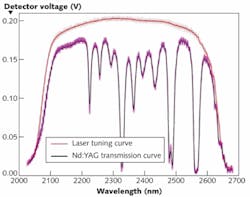MID-INFRARED LASERS: Fiber-bulk hybrid mid-IR laser is broadly tunable over 1000 nm

Many mid-infrared (mid-IR) solid-state laser sources do not operate at room-temperature due to the deactivation of energy accumulated in the gain media via nonradiative phonon-assisted decay. But a new class of impurity-doped crystalline lasers based on transition-metal (chromium, Cr2+ or iron, Fe2+) doped binary (ZnSe, ZnS, CdSe, CdS) and ternary (for example, CdMnTe) chalcogenide crystals represents a viable route for room-temperature mid-IR lasing and expands the capabilities of other mid-IR coherent sources. These gain media can be pumped by commercially available erbium (Er) and thulium (Tm) fiber lasers, feature strong and ultrabroad absorption and emission bands in the mid-IR (σ approximately 10-18 cm2 and a gain bandwidth up to 50% of the central wavelength), and do not have excited-state absorption. Heavy anions in the crystals provide a very low-energy optical-phonon cutoff enabling high room-temperature fluorescence yield.
Since their introduction in the late 1990s by William Krupke’s group at Lawrence Livermore National Laboratory (LLNL; Livermore, CA), Cr2+ and Fe2+ doped II-VI semiconductor lasers were demonstrated with laser efficiencies greater than 70%, maximum continuous-wave (CW) powers greater than 18 W, short pulse oscillations less than 80 fs, peak powers greater than 1 GW, output energies greater than 20 mJ, and overall tunability over a 2–5 μm range, leading some researchers to call them the “mid-IR analogs of Ti:sapphire lasers”.1-3 These lasers are now commercially available from IPG Photonics in the form of fiber-bulk hybrid systems.4
Broad tunability, various temporal outputs
Three major types of fiber-bulk hybrid lasers convert CW radiation from fiber lasers either in the spectral domain (broadly tunable radiation), the temporal domain (modelocked or short Q-switched, high peak power and energy pulses), or simultaneously in the spectral and temporal domains.
For the first series of lasers with 1000 nm tunability from 2000 to 3000 nm (and a rapid-tuning capability of less than 0.7 μs/nm), an Er or Tm CW randomly polarized fiber laser with output power ranging from 1 to 30 W pumps an external-cavity tunable laser based on Cr:ZnS/Se bulk crystals. The result is CW mid-IR tunable, narrow-linewidth (less than 0.05 nm) or single-frequency radiation with output power in excess of 10 W and a real optical-to-optical efficiency up to 50%.
Temporal-domain conversion models are divided into two groups capitalizing on a) the ultrabroadband gain profile of the pumped medium, enabling short pulse duration in the modelocked regime, or b) long lifetime of the optical centers (Er or holmium [Ho]) in the excited states, enabling effective accumulation of population inversion and efficient Q-switching.
Fiber-pumped mode-locked Cr:ZnS/Se lasers are somewhat similar to green-laser-pumped femtosecond Ti:sapphire lasers and can provide short (less than 10 fs) modelocked operation with watt-level output power, but in the spectral range that contains molecular fingerprints of organic molecules.
Fiber-pumped actively or passively Q-switched Er or Ho:YAG lasers effectively (up to 90%) convert CW radiation of Er or Tm fiber lasers into high-energy (0.5 to 20 mJ) Q-switched radiation of Er:YAG (1.6 μm) or Ho:YAG (2.1 μm) lasers with a variable pulse duration (5 to 200 ns) and repetition rate (10 to 80,000 Hz).
Combinations of temporal/spectral conversion models can create Cr(Fe):ZnS/Se gain-switched lasers with output energy up to 10 mJ, pulse duration of 10 to 100 ns, repetition rate of 50 to 5000 Hz, and tunability over the 2–3 µm and 3.5–5.2 µm spectral ranges.
Broad applications coverage
“Low-cost, mass-producible crystal fabrication by post-growth thermal diffusion of impurities and availability of convenient pump sources such as InGaAsP/InP diode lasers and Er/Tm fiber lasers make transition-metal doped chalcogenides ideal candidates for broadly tunable mid-IR lasing in CW, gain-switched, and modelocked regimes of operation,” says Sergey Mirov, director of mid-infrared lasers at IPG Photonics. “The combination of high values of saturation cross-section, small saturation energy, reasonable damage threshold of 2 J/cm2, and high thermal conductivity of ZnSe and ZnS hosts makes Cr2+ and Fe2+:ZnSe/S crystals ideal materials for passive Q-switching of near- and mid-IR laser cavities.”
REFERENCES
1. L. D. DeLoach et al., IEEE J. Quantum Electron., 32, 885–895 (1996).
2. T. Sorokina et al., Optical Mats., 26, 395–412 (2004).
3. S. Mirov et al., Laser & Photon. Rev., 4, 1, 21–41 (2010).
4. www.ipgphotonics.com/midir.
About the Author

Gail Overton
Senior Editor (2004-2020)
Gail has more than 30 years of engineering, marketing, product management, and editorial experience in the photonics and optical communications industry. Before joining the staff at Laser Focus World in 2004, she held many product management and product marketing roles in the fiber-optics industry, most notably at Hughes (El Segundo, CA), GTE Labs (Waltham, MA), Corning (Corning, NY), Photon Kinetics (Beaverton, OR), and Newport Corporation (Irvine, CA). During her marketing career, Gail published articles in WDM Solutions and Sensors magazine and traveled internationally to conduct product and sales training. Gail received her BS degree in physics, with an emphasis in optics, from San Diego State University in San Diego, CA in May 1986.